Resilient Smart Gardens—Exploration of a Blueprint
Abstract
1. Introduction
What are the insights from and challenges for developing a small-scale resilient smart garden from scratch using off-the-shelf components and permaculture principles?
2. Background
2.1. Small-Scale Water Conservation Projects
2.2. Other RSGs and Systems Used in Farming
2.3. Garden Monitoring Systems
2.4. Other Micro-Controller Projects
2.5. Other Educational Garden Kits
2.6. Permaculture Principles
“Permaculture is primarily a consciously designed agricultural system … a system that combines landscape design with perennial plants and animals to make a safe and sustainable resource for town and country”.[20] (p. 2)
2.7. Preliminary Work
3. Research Design
3.1. Context: Undergraduate Summer Research
3.2. Research Vision
3.3. Educational Strategy
3.4. Data Collection and Analysis
4. Implementation of the Resilient Smart Garden
4.1. Gardenware Set-Up
- For each planter, make two rectangular holes of the dimesions 0.5 cm height times 1.5 cm width on the two opposite holes to attach the humidity and temperature sensors.
- Drill a smaller hole along the other two walls of the planter.
- Put the five feet vinyl tube and arrange it along the interior side of the planter. Use zip ties to tie it to the planter and then use the plugs to seal one end of each vinyl tube. Then, use the pins to poke small holes along the vinyl tube to let the water spray towards the plants through these holes.
- Attach the water pump to the other end of each vinyl tube and place the water pumps connected to the vinyl tube into the bucket.
- Place the plants in the planters, fill the planter with soil and place the moisture sensor directly into the soil in the middle of the planter. Finally, put an LED strip on the wall of the planters.
4.2. Hardware Set-Up
4.3. Software Set-Up
5. Results
5.1. Project Diary
5.2. Garden Observations
5.3. Moisture, Temperature, and Humidity Data
5.4. Reflective Essays
- New Skills. Students embraced the opportunity for acquiring new skills, related to the project in terms of hardware design, embedded technology, and gardening skills, but also beyond, e.g., as expressed by one of them: “This project was also valuable in teaching me life skills including project management, time management, self management, and learning to adapt to unforeseen circumstances.”
- Freedom in Team Work. They appreciated the leeway they were given to self-organize: “Having a general timeline provided us direction for the summer research project while not restricting the approach to meeting the timeline specifications or intrude with our team’s culture or methods of productivity.” In addition, they “were able to divide the work between everyone and everyone tried to get their assigned tasks done on time. The dynamic also carried over from the spring semester so there was never a dull moment.”
- Safe-to-fail. The students learned that research may require several attempts at accomplishing something, as “in research things are expected to (sometimes) go wrong and it is part of the process of improving the system and finding what works best.” Furthermore, the team was helping in recovering from setbacks: “When something happened with the garden, it was treated as more of an adventure than a tragedy. We were all able to laugh it off and then try to work and figure out what was going on with the system.”
- Pain Points. The restrictiveness of the wireless network, the tediousness of acquisition reimbursements, and the requested documentation were the identified pain points: “Honestly, I disliked documenting step by step procedure to replicate the project”. However, they also figured out that “doing documentation as you progress through your project is much easier and less stressful than waiting for the end to get it done all at once.”
5.5. Affordability and Continuity
6. Discussion
6.1. Computing within Limits
- Natural limits: We only had two small planters due to little space and used a simple water bucket solution with a pump for the automated watering. Outdoors, this would be using grey water. In addition, we used means like companion planting to increase harvest.
- Economic limits: The constraints of a small budget made us stick to the bare essentials—we were able to keep the costs at $192, of which $25 were spent on garden ware that can mostly be reused, about $25 on seedlings and soil, and the rest on the computational and electronics hardware setup. We are confident that this can be further reduced in the future, as we had to start from scratch with no reusable old parts of any kind.
- Technical limits: The sensors and boards were very basic and the software had to work with the limited availability of computing power.
- Bridging Disciplines. In many topic areas relevant to limits, we have to bridge disciplines. While we had only computer science students working on this project, the topic would have lent itself well to an interdisciplinary team.
- Companion Planting. The method mentioned above that we used in the project is companion planting. It is a technique that helps get the highest possible yield out of a limited amount of land by using synergies between plants. For example, the first one works as a nitrogen fixer for the second one that, in turn, provides shade for the first one.
- Non-computational Solution Alternatives. There is justified skepticism of approaches for decreasing consumption of water or other resources that simultaneously employ active means like sensors, actuators, software, artificial lighting, etc. These are often omitting much simpler, tried-and-true passive means like tenting/greenhouses, ollas, and increased-organic-matter soils. The research project at hand uses active means because it was a feasible way to expose computer science students to a hands-on agricultural topic.
6.2. Benefits
6.2.1. Fun
6.2.2. Hands-on, Self-Guided Work
6.2.3. Educating in a Safe Space
6.2.4. Connection to Permaculture
6.2.5. Scalability
6.2.6. Flexibility and Variety
6.2.7. Wireless
6.3. Limitations
6.3.1. Indoor Setup and Power Supply
6.3.2. Maintainability
6.4. Future Work
6.4.1. Outdoors
6.5. Innovation Challenge
6.5.1. User Intention
6.5.2. Scalability
6.5.3. Greywater Solution
6.5.4. Education Kit
7. Conclusions
Author Contributions
Funding
Acknowledgments
Conflicts of Interest
References
- Rees, W.E. Thinking “resilience”. In The Post Carbon Reader: Managing the 21st Century’s Sustainability Crises; Watershed Media: Healdsburg, CA, USA; Post Carbon Institute: Santa Rosa, CA, USA, 2010. [Google Scholar]
- Dixon, G.R.; Collier, R.H.; Bhattacharya, I. An assessment of the effects of climate change on horticulture. In Horticulture: Plants for People and Places; Springer: Berlin, Germany, 2014; Volume 2, pp. 817–857. [Google Scholar]
- Sardans, J.; Peñuelas, J. Drought decreases soil enzyme activity in a Mediterranean Quercus ilex L. forest. Soil Biol. Biochem. 2005, 37, 455–461. [Google Scholar] [CrossRef]
- Crate, S.; Nuttal, M. Anthropology and Climate Change: From Encounters to Actions; Political Theory and Global Climate Change. Ethics Policy Environ. 2012, 15, 125–129. [Google Scholar] [CrossRef]
- Legislative Analyst’s Office. The 2016–17 Budget: The State’s Drought Response; Technical Report; Legislative Analyst’s Office: Sacramento, CA, USA, 2016. [Google Scholar]
- Parmesan, C. Ecological and Evolutionary Responses to Recent Climate Change. Annu. Rev. Ecol. Evol. Syst. 2006, 37, 637–669. [Google Scholar] [CrossRef]
- Howitt, R.; Medellín-azuara, J.; Macewan, D. Economic Analysis of the 2014 Drought for California Agriculture; Center for Watershed Sciences, University of California: Davis, CA, USA, 2014; 20p. [Google Scholar]
- Adger, W.N.; Arnell, N.W.; Tompkins, E.L. Successful adaptation to climate change across scales. Glob. Environ. Chang. 2005, 15, 77–86. [Google Scholar] [CrossRef]
- The National Gardening Association. National Gardenting Association Special Report: Garden to Table: A 5 Year Look at Food Gardening in America; The National Gardening Association: Jacksonville, TX, USA, 2014; p. 24. [Google Scholar]
- Meyer, M.H.; Needham, D.; Dole, J.; Trader, B.; Fox, J.; Conley, M.; Neff, M.; Shaw, J. Importance of horticulture and perception as a career. HortTechnology 2016, 26, 114–120. [Google Scholar]
- National Institute of Food and Agriculture. USDA Definition of Specialty Crop; National Institute of Food and Agriculture: Washington, DC, USA, 1893. [Google Scholar]
- Fan, L.; Wang, F.; Liu, G.; Yang, X.; Qin, W. Public Perception of Water Consumption and Its Effects on Water Conservation Behavior. Water 2014, 6, 1771–1784. [Google Scholar] [CrossRef]
- Domene, E.; Saurí, D.; Parés, M. Urbanization and Sustainable Resource Use: The Case of Garden Watering in the Metropolitan Region of Barcelona. Urban Geogr. 2005, 26, 520–535. [Google Scholar] [CrossRef]
- Caetano, F.; Pitarma, R.; Reis, P. Advanced System for Garden Irrigation Management; Advances in Intelligent Systems and Computing Series; Springer: Berlin, Germany, 2015; Volume 353, pp. 565–574. [Google Scholar]
- Duan, X.J. Research on IOT-Based Smart Garden Project. Computer-Aided Design, Manufacturing, Modeling and Simulation IV. Appl. Mech. Mater. 2014, 608–609, 321–325. [Google Scholar] [CrossRef]
- GreenIq. GreenIQ, 2017. Available online: https://greeniq.com/ (accessed on 28 July 2018).
- Attari, S.Z. Perceptions of water use. Proc. Natl. Acad. Sci. USA 2014, 111, 5129–5134. [Google Scholar] [CrossRef] [PubMed]
- Hatton-Jones, S.; Teah, M. Case analysis of the do-it-yourself industry. Asia Pac. J. Mark. Logist. 2015, 27, 826–838. [Google Scholar] [CrossRef]
- Marques, M.; Ochoa, S.; Bastarrica, M.C.; Gutierrez, F. Enhancing the Student Learning Experience in Software Engineering Project Courses. IEEE Trans. Educ. 2018, 61, 63–73. [Google Scholar] [CrossRef]
- Mollison, B.; Holmgren, D. Permaculture; Lesmurdie Progress Association: Perth, Australia, 1978. [Google Scholar]
- Maleficarum, M. Water Saving System Using Arduino; Autodesk Inc.: San Rafael, CA, USA, 2016. [Google Scholar]
- Amberg, T. Augmented Water; Amberg Thomas: Zurich Area, Switzerland, 2016. [Google Scholar]
- Van der Lee, R. Gallardo Patricio. In Vinduino, a Wine Grower’s Water Saving Project; Supplyframe Inc.: Pasadena, CA, USA, 2015. [Google Scholar]
- Palmer Andrew. Smart Sprinkler: Water Saving Irrigation Controller for Residential Use; Cornell ECE, Cornell University: Ithaca, NY, USA, 2015. [Google Scholar]
- E2i Creative Studio. Connected Garden; E2i Creative Studio: Orlando, FL, USA, 2013. [Google Scholar]
- Vashista, A.; Rathore, H.; Jain, G. Automatic Gardening System using Arduino. SSRG Int. J. Electron. Commun. Eng. 2016, 3, 119–120. [Google Scholar]
- Carson, M. Automated Aquaponics Design Report; Technical Report; ECE: Milwaukee, WI, USA, 2015. [Google Scholar]
- Massachusetts Institute of Technology. Personal Food Computers; Massachusetts Institute of Technology: Cambridge, MA, USA, 2017. [Google Scholar]
- Edyn. Edyn; Edyn: Oakland, CA, USA, 2017. [Google Scholar]
- Daniels, D.V. Automatic Garden Watering Device—Arduino; Autodesk Inc.: San Rafael, CA, USA, 2016. [Google Scholar]
- Aqib, M. Advanced Garduino with Data Logging to Database; hackster.io: Avnet, Phoenix, AZ, USA, 2017; Available online: https://www.hackster.io/muhammad-aqib/advanced-garduino-with-data-logging-to-database (accessed on May 8 2018).
- Hamza, A. How to Make an Arduino Temperature Data Logger. 2017. Available online: https://maker.pro/arduino/projects/make-arduino-temperature-data-logger (accessed on May 8 2018).
- Iseman, L. Garduino: Geek Gardening with Arduino; Maker Media: San Francisco, CA, USA, 2012. [Google Scholar]
- Partnership, P. Bee Smart Kit for Elementary School Kids. 2017. Available online: http://pollinator.org/bee-smart (accessed on 8 February 2018).
- Tower Garden. 6 Reasons Tower Garden Is a Great Teaching Tool; The Juice Plus+ Company: Collierville, TN, USA, 2017; Available online: http://www.towergarden.com/grow/school-gardens{#}intro (accessed on 8 February 2018).
- Heitlinger, S.; Bryan-Kinns, N.; Jefferies, J. UbiComp for Grassroots Urban Food-growing Communities. In Proceedings of the 2013 ACM Conference on Pervasive and Ubiquitous Computing Adjunct Publication (UbiComp ’13 Adjunct), Zurich, Switzerland, 8–12 September 2013; ACM: New York, NY, USA, 2013; pp. 589–594. [Google Scholar] [CrossRef]
- Holmgren, D. Permaculture: Principles & Pathways Beyond Sustainability; Holmgren Design Services: Channon, Australia, 2002. [Google Scholar]
- Camarena, A.; Chavis, J.; Leung, T.C. Resilient Smart Gardens; Senior Design Project; California State University–Long Beach: Long Beach, CA, USA, 2016. [Google Scholar]
- Penzenstadler, B.; Plojo, J.; Sanchez, M.; Marin, R.; Tran, L.; Khakurel, J. The DIY Resilient Smart Garden Kit. In Proceedings of the Workshop on Computing within Limits (LIMITS), Calgary, AB, Canada, 6–7 November 2018. [Google Scholar]
- Norton, J.; Stringfellow, A.J.; Laviola, J.J., Jr.; Penzenstadler, B.; Tomlinson, B. Domestic Plant Guilds: A Software System for Sustainability. In Proceedings of the 2nd International Workshop on Requirements Engineering for Sustainable Systems (RE4SuSy), Rio, Brasil, 15 July 2013; CEUR WS: Aachen, Germany, 2013. Available online: CEUR-WS.org/Vol-995 (accessed on 8 February 2018).
- Experiencing Research Through OurCS: Opportunities for Undergraduate Research in Computer Science. In Proceedings of the 3rd Annual Conference for Research on Equity & Sustained Participation in Computing, Engineering, & Technology (RESPECT 2018), Baltimore, MD, USA, 21 February 2018.
- Lightman, A. Praise of Wasting Time; TED: New York, NY, USA, 2018. [Google Scholar]
- Atwood, J. Rubber Duck Problem Solving. Coding Horror Blog, 13 March 2012. [Google Scholar]
- Plotly. Modern Visualization for the Data Era, 2018. Available online: https://plot.ly/ (accessed on 8 February 2018).
- Nardi, B.; Raghavan, B.; Goldweber, M. Fourth Workshop on Computing within Limits, 2018. Available online: http://computingwithinlimits.org/ (accessed on 8 February 2018).
- Nardi, B.; Tomlinson, B.; Patterson, D.; Chen, J.; Pargman, D.; Raghavan, B.; Penzenstadler, B. Computing within Limits. Commun. ACM 2018, in press. [Google Scholar]
- CSULB Institute for Innovation and Entrepreneurship. Experience the Innovation Challenge, 2018. Available online: www.csulb.edu/innovation-challenge?mc_cid=48a727fb55&mc_eid=976194950a (accessed on 8 February 2018).
- Vang, K.; Zoldoske, D. Irrigation Management; California Ag Water Stewardship Initiative: Davis, CA, USA. Available online: http://agwaterstewards.org/practices/irrigation{_}management/ (accessed on 8 February 2018).
- Margolis, J. Growing Food in the Desert: Is This the Solution to the World’s Food Crisis; The Guardian: Manchester, UK, 2012. [Google Scholar]

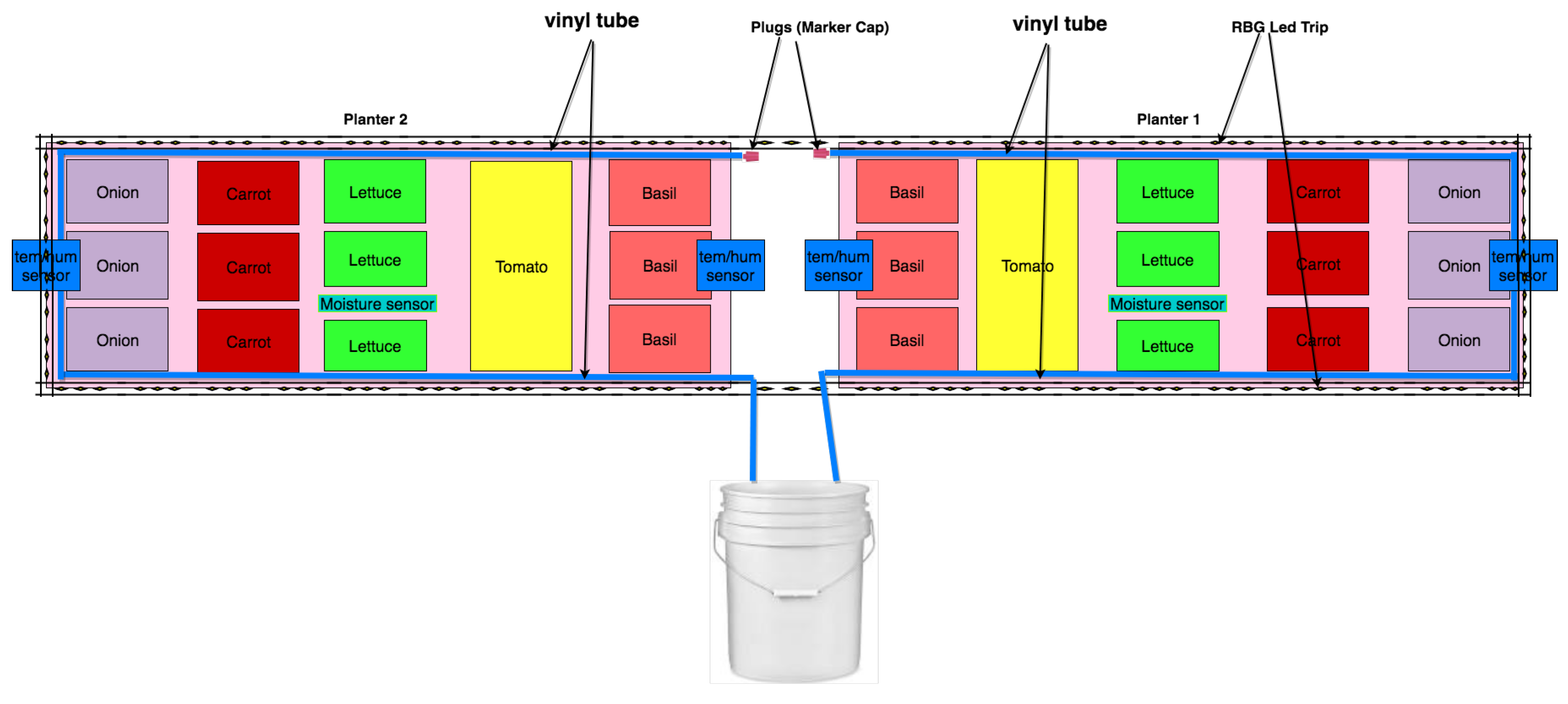
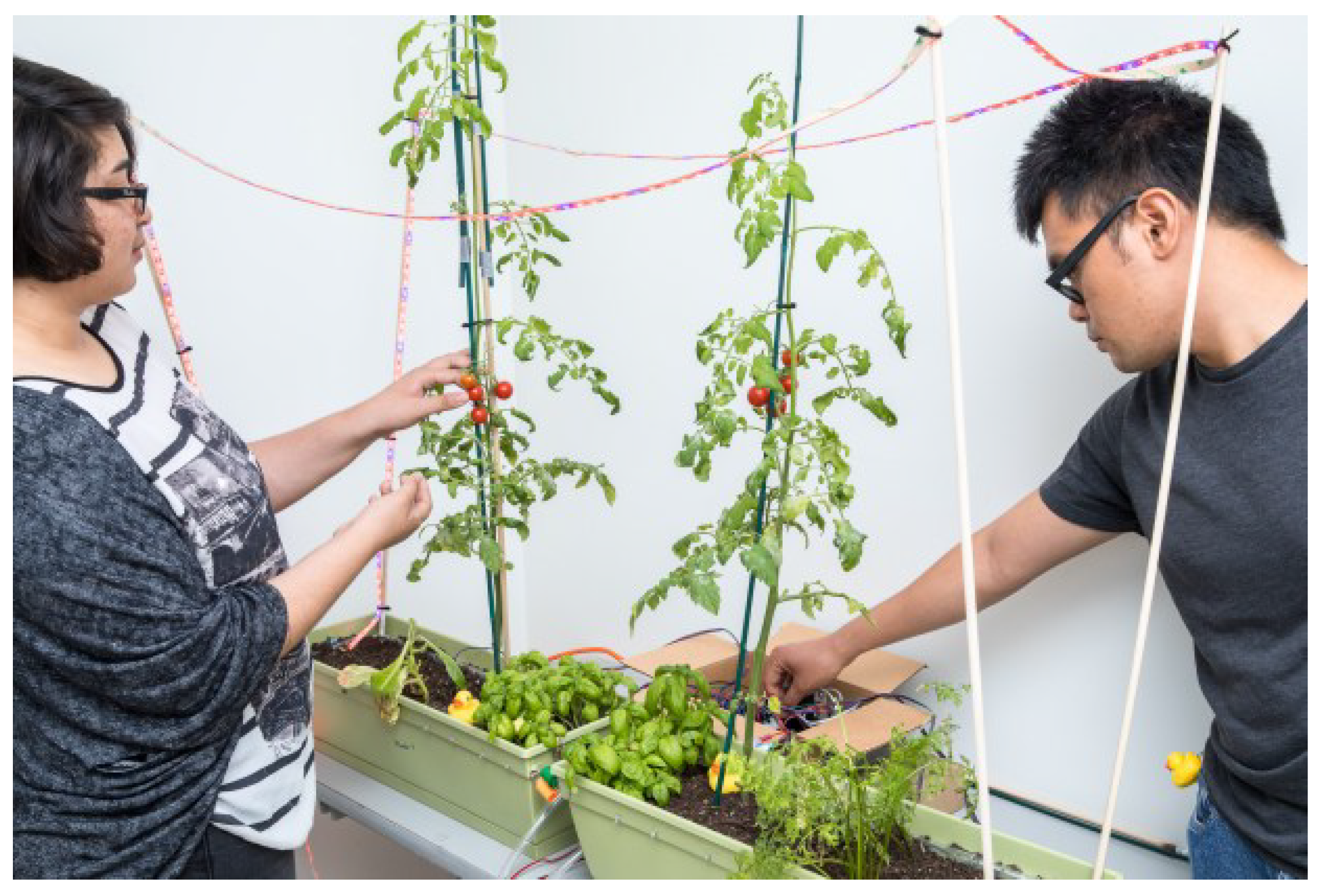
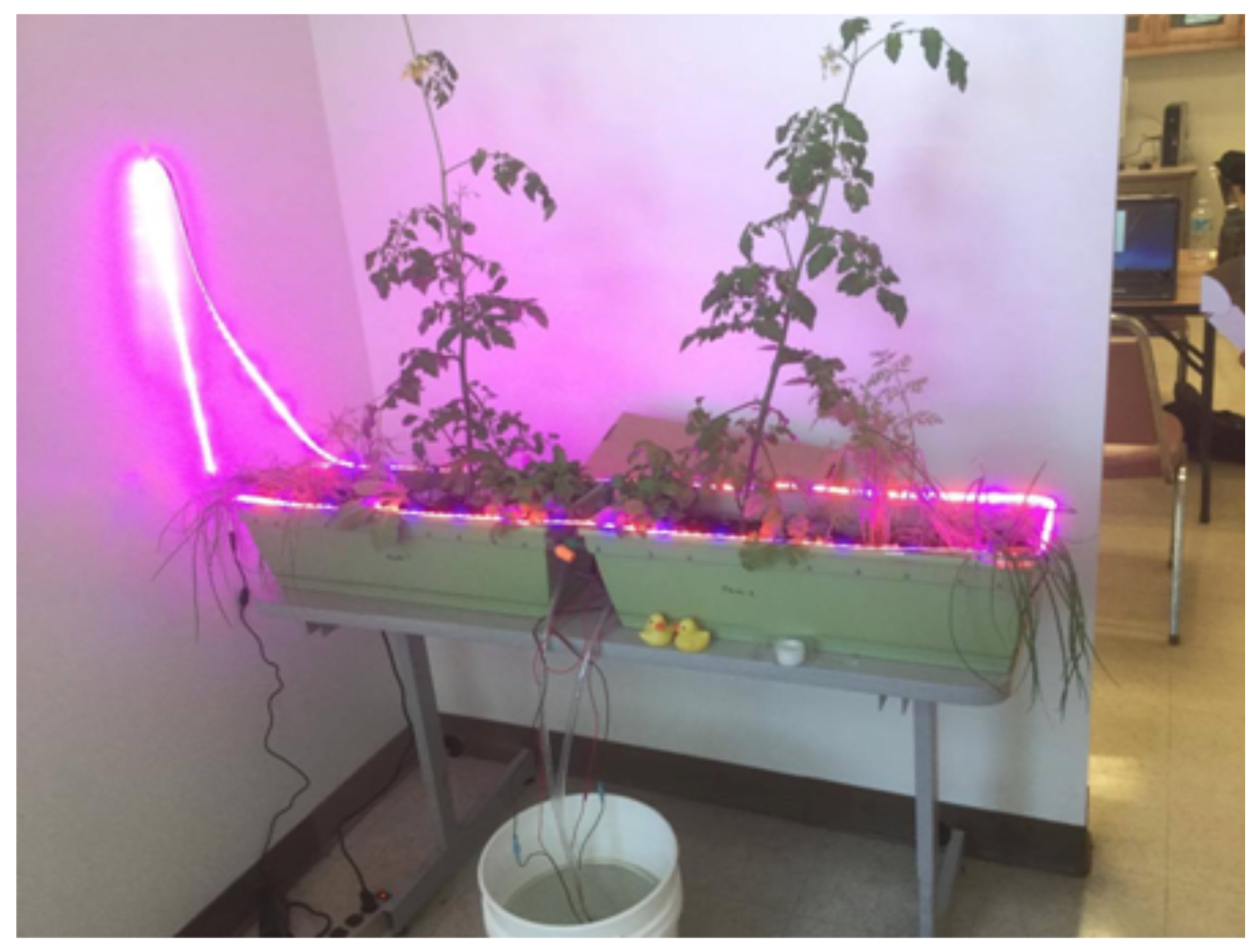
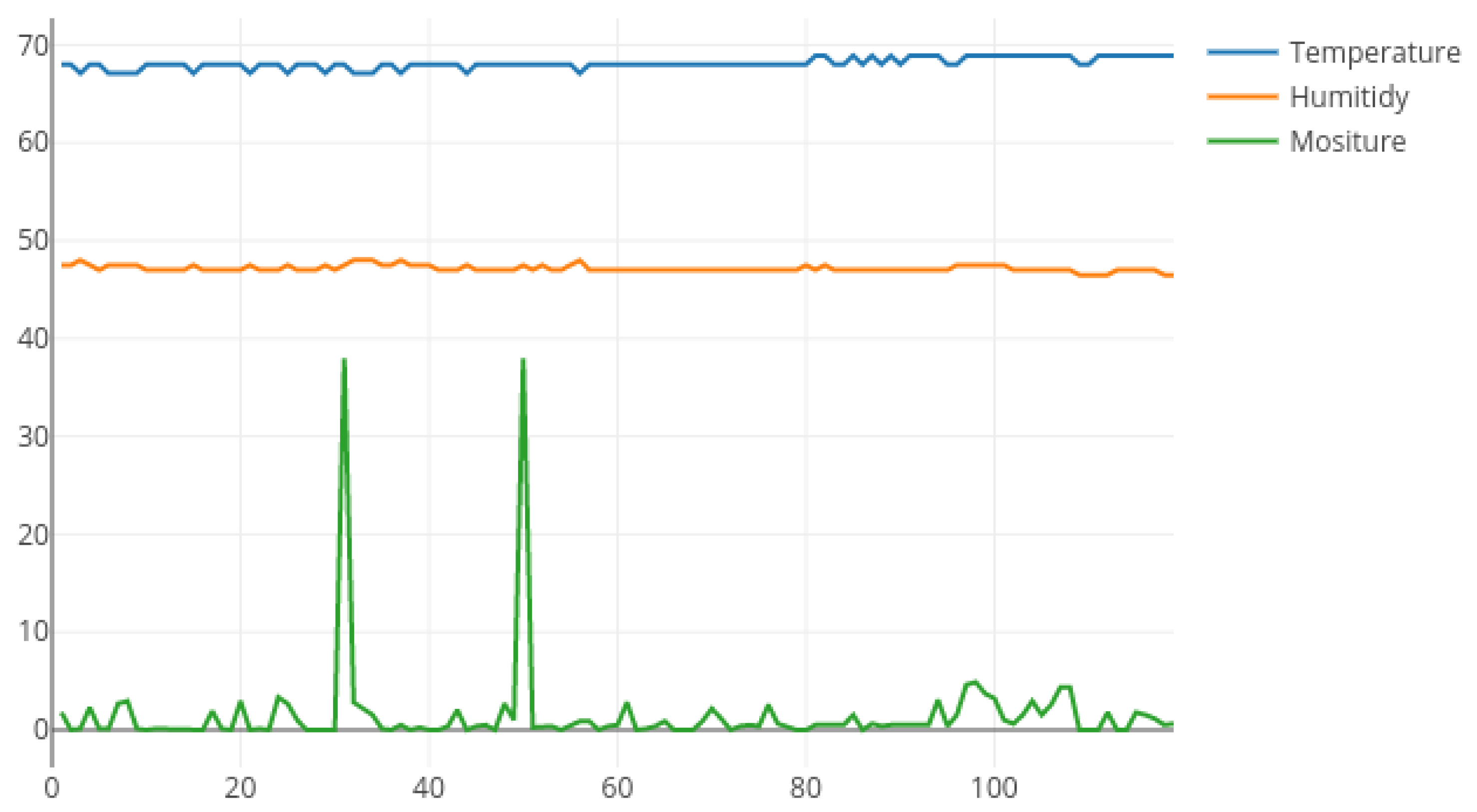
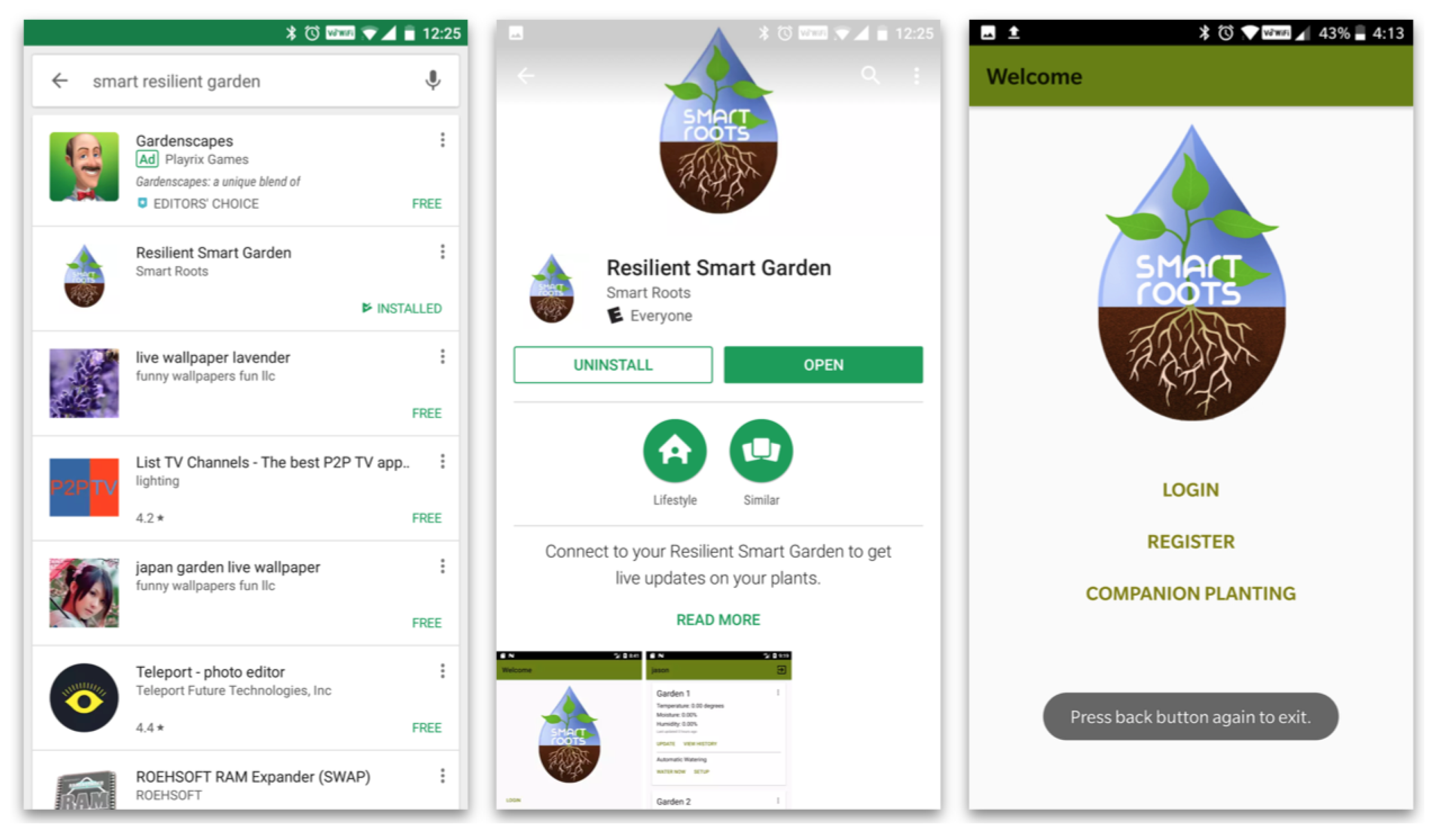
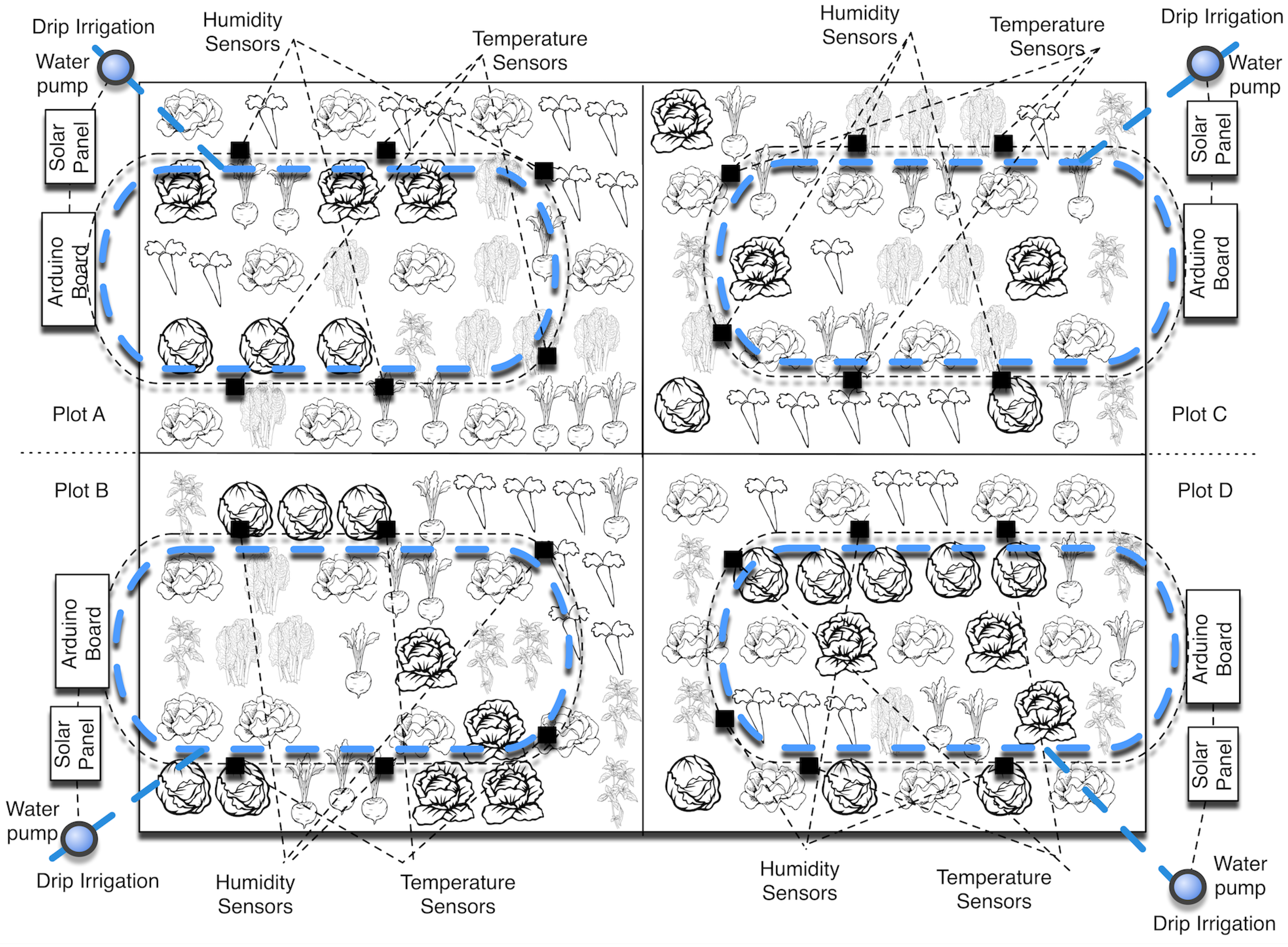
| Project | Description | Pro | Con |
|---|---|---|---|
| Maleficarum [21] | water conservation system for washing machine to toilet grey-water reuse | grey-water reuse | inadequate for classroom project |
| Amberg [22] | micro-controller and a flow sensor to measure and flag water usage | water conservation | inadequate scope for summer project |
| Vinduino [23] | reduces agricultural water consumption in a vineyard | water conservation | inadequate for classroom project |
| Palmer [24] | clock-based irrigation controller | water conservation | inadequate scope for summer project |
| Connected Garden [25] | outdoor garden and used sensors controlled by a micro-controller board to collect data | monitoring | no intervention |
| Guarduino [26] | sensors connected to micro-controller for feedback on irrigation | water conservation | no intervention |
| Automated Aquaponics Design Report [27] | monitors both the condition of a garden as well as a fish tank | aquaponics | scope too large for summer project |
| OpenAg [28] | personal food computer in closed environment | encompassing system solution | scope too large for summer project |
| Edyn Smart Garden System [29] | automated garden monitoring and irrigation | commercial-off-the-shelf | no do-it-yourself component |
| GreenIQ Smart Garden Hub [16] | automated garden monitoring and irrigation | commercial-off-the-shelf | no do-it-yourself component |
| Daniels [30] | instructions to make an outdoor automatic garden watering device | ||
| Aqib [31] | advanced automatic watering garden tutorial | ||
| Hamza [32] | making a temperature data logger | instructions for part of project | missing context adaptation |
| Iseman [33] | automatic watering garden using DIY moisture sensors | DIY sensors | too detailed for our scope |
| Bee Smart kit [34] | educational miniature garden | complete kit for schools | no do-it-yourself component, intended for different audience |
| Tower Gardens school kit [35] | educational aeroponics garden | complete kit for schools | no do-it-yourself component, intended for different audience |
| Day Zero: Ducks everywhere | Got a set of rubber ducks for the lab for rubber duck debugging [43]. They have names and make people smile when they enter the lab. |
| 22 May, Shopping | Worked on shopping lists for both garden and hardware components. Finding planters and soil was relatively easy. Finding the prices for seedlings online was more tricky for the cost estimation, as many of them weren’t listed. |
| Memorial Day, Remote Work | Included some soldering and WiFi module research. The students were so motivated for the project to even put in work on a holiday. |
| 5 June, Irrigation system | We did not have power tools, a power drill specifically, on hand. We had to manually make holes using scissors, screwdriver, and wire cutters. We made use of whatever we had available at any given time. |
| 7 June, WiFi problems | Attempting to get the garden system to communicate with the server has a snag with the campus WiFi. The school is using WPA2 Enterprise encryption and PEAP protocol for user and password authentication. The current stable library for the WiFi module does not support this feature. Temporary solution: Tethering over phone. We now found a permanent solution using a library. |
| 19 June Pests detected | Only 1 of the 4 lettuces initially planted in the planters is alive, and currently struggling. We found a few pests: vine lice were found on the chives in planter 2, a cocooned caterpillar (Shield) was found on the leaves of the lettuce in planter 1, and a caterpillar (Little Jerkwad) ate a good portion of the leaves of the carrots in planter 1. |
| 21 June, Pest control | Vinegar, get the damn pests away. That worked only partially, and one plant died supposedly because of too much vinegar sprayed. |
| 22 June, First flood | Opening the door revealed a big flood on the floor and an empty water bucket. My first reaction is to turn off the power strip. |
| 27 June, Partial solution | Online research suggests that having capacity constantly powered in a moist environment will enhance the corrosion on the capacitor. We minimized the time the sensors are powered. |
| 5 July, Project enclosure | It turns out that the temperature/humidity sensor was mounted upside down, which flipped the polarity causing a short. Remounting the temperature/humidity sensor is unfortunately not an easy option for us, so we flipped the wiring on the micro-controller and breadboard instead. |
| 19 July, Press coverage | In the afternoon, a video team from IEEE Computer Society came in and interviewed us while taking B-Roll shots of the garden and the system. The project got more attention than we expected. |
| 31 July, Harvest | Tomatoes in planter 2 are beginning to split open. We picked them. At this point, the plant also had too little room and started to deteriorate. |
| 19 June | 21 June | 28 June | 5 July | 12 July | 26 July | 31 July | 9 August | |
|---|---|---|---|---|---|---|---|---|
| Height | 34” | 37.5” | 46” | 4’7” | 3’10” (plant snapped) | 4’1” | 4’1” | 4’1” |
| Color | green | green | green | green | green | green | brownish, light green yellowish color on leaves and branches | leaves and branches appear to be drier and shriveling |
| Critter status | none | none | none | white fuzzy stuff on leaves | white fuzz on more of the leaves | white fuzz on leaves | none | none |
| Appear -ance | healthy dark green color with yellow flowers, leaves are healthy | fruits are ginning to grow from the flowers, some tomatoes still have the blooms hanging from the end of the fruit, tiny and green | healthy dark green color; leaves are healthy; tomatoes are growing larger; 4 flowers | healthy dark green color; more flowers; tomatoes larger with stripes along side; plant leaning; some leaves curling | leaves are green, tomatoes are slowly turning red; 1 is still green and 3 are red, plant looks lush and fuller | leaves are a lighter green color, all 4 fruits are red | Fruits have been picked due to cracking, two got infected. Leaves are withering and beginning to wilt | Plant looks less healthy; leaves are shriveling; the pigment along the stem and branches is beginning to turn brown. |
| Fruit (if) | 4 | 4 | 4 | 4 | 4 | 4 | 0 | 0 |
| Hardware | Price | Qty | Total | Notes |
|---|---|---|---|---|
| 12 v 1 a Power Supply | $8.66 | 1 | $8.66 | To power the water pump |
| Terminal Strip (5 Pack) | $11.61 | 1 | $11.61 | To distribute power to water pumps from power supply |
| HiLetgo NodeMCU WiFi ESP8266 | $8.79 | 1 | $8.79 | WiFi module |
| Tolako 5 v Relay Module | $5.80 | 2 | $11.60 | To turn on water pump |
| OctagonStar DHT11 (4 Pack) | $7.66 | 1 | $7.66 | Temperature and Humidity sensors |
| Docooler 12 v Water Pump | $10.35 | 2 | $20.70 | 2 water pumps for the two planters |
| 50 Ft Vinyl Tubing | $15.99 | 1 | $15.99 | To deliver the water to the garden. |
| Phantom YoYo High Sensitivity Water Sensor | $6.98 | 2 | $13.96 | Moisture sensors |
| Beard Board (3 Pack) | $7.49 | 1 | $7.49 | To wire up the WiFi module and Arduinos |
| Logic Level Converter (5 Pack) | $6.99 | 1 | $6.99 | For communication between Arduinos and WiFi module |
| USB Power Strip | $14.99 | 1 | $14.99 | 2 standard plugs, 3 USB ports to power all electronics |
| 6 Ft USB A to B | $1.29 | 2 | $2.58 | To power and program the two Arduino boards |
| Wire for Power Cord, 25 feet. | $8.99 | 2 | $17.98 | For powering |
| Wire Cable Connector Fork Spade | $8.10 | 1 | $8.10 | For connecting the wires (200 pieces, for several projects)) |
| 3 Ft Micro USB | $1.99 | 1 | $1.99 | To power and program WiFi Module/Garden Manager |
| Planters (24 in.) | $7.47 | 2 | $14.94 | 24 inches long |
| Soil (1 cu. ft.) | $3.97 | 1 | $3.97 | For planters |
| Shovel | $0.99 | 1 | $0.99 | For planting |
| Cherry tomato | $2.99 | 2 | $5.98 | No Tax. |
| Basil | $3.99 | 1 | $3.99 | No Tax. Pack of 6 plants |
| Carrot | $3.99 | 1 | $3.99 | No Tax. Pack of 6 plants |
| Onion | $3.99 | 1 | $3.99 | No Tax. Pack of 6 plants |
| Lettuce | $3.99 | 1 | $3.99 | No Tax. Pack of 6 plants |
| Total before Tax | $174.85 | |||
| Total After Tax | $191.92 |
© 2018 by the authors. Licensee MDPI, Basel, Switzerland. This article is an open access article distributed under the terms and conditions of the Creative Commons Attribution (CC BY) license (http://creativecommons.org/licenses/by/4.0/).
Share and Cite
Penzenstadler, B.; Khakurel, J.; Plojo, C.J.; Sanchez, M.; Marin, R.; Tran, L. Resilient Smart Gardens—Exploration of a Blueprint. Sustainability 2018, 10, 2654. https://doi.org/10.3390/su10082654
Penzenstadler B, Khakurel J, Plojo CJ, Sanchez M, Marin R, Tran L. Resilient Smart Gardens—Exploration of a Blueprint. Sustainability. 2018; 10(8):2654. https://doi.org/10.3390/su10082654
Chicago/Turabian StylePenzenstadler, Birgit, Jayden Khakurel, Carl Jason Plojo, Marinela Sanchez, Ruben Marin, and Lam Tran. 2018. "Resilient Smart Gardens—Exploration of a Blueprint" Sustainability 10, no. 8: 2654. https://doi.org/10.3390/su10082654
APA StylePenzenstadler, B., Khakurel, J., Plojo, C. J., Sanchez, M., Marin, R., & Tran, L. (2018). Resilient Smart Gardens—Exploration of a Blueprint. Sustainability, 10(8), 2654. https://doi.org/10.3390/su10082654





